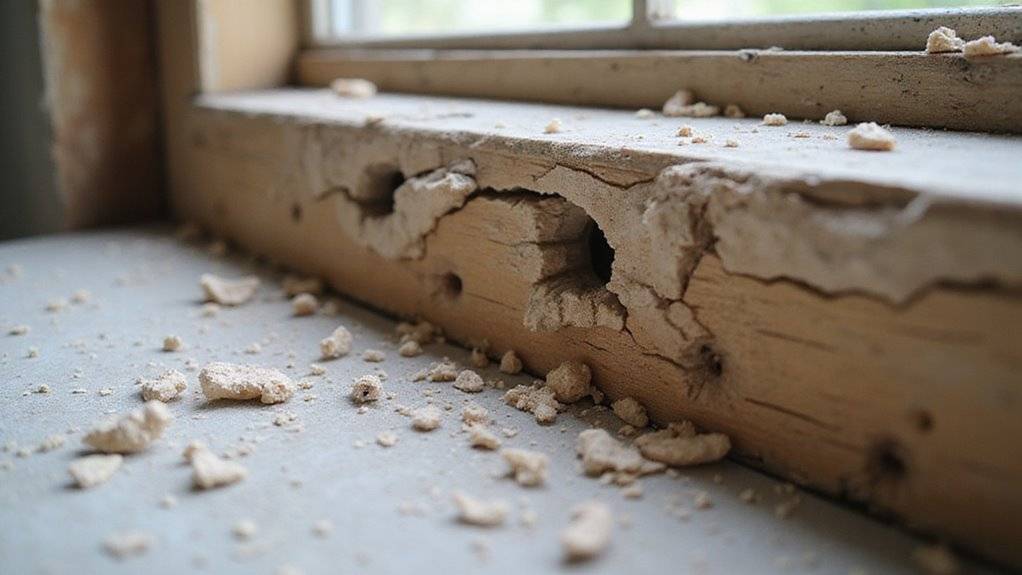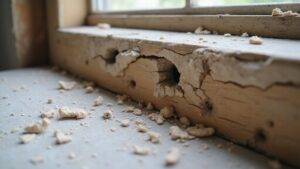Buying a home can be stressful, especially when you worry about hidden damage. Termite or pest problems are often hard to spot. Small signs like bubbling paint could mean big trouble.
Missing these clues can lead to costly repairs after you move in. You might also lose money during price negotiations. Many buyers do not know what to look for and regret it later. Buyers should look for subtle signs of termite or pest damage, not just obvious wood problems, to protect their investment.
This blog will show you key things inspectors check first. You will learn how to spot trouble early and avoid expensive mistakes. This blog will guide you through the most important signs to watch for and help you avoid costly surprises.
Key Takeaways
- Blistered, peeling, or hollow-sounding wood often signals hidden termite or pest damage beneath surfaces.
- Mud tubes along foundations and walls indicate active or previous termite infestations.
- Discarded insect wings near windows or doors suggest recent termite swarms or colony formation.
- Small piles of sawdust, frass, or insect droppings point to ongoing pest activity inside the home.
- Persistent musty odors or unusual wall stains can reveal hidden pest problems related to moisture and infestation.
Visible Wood Damage
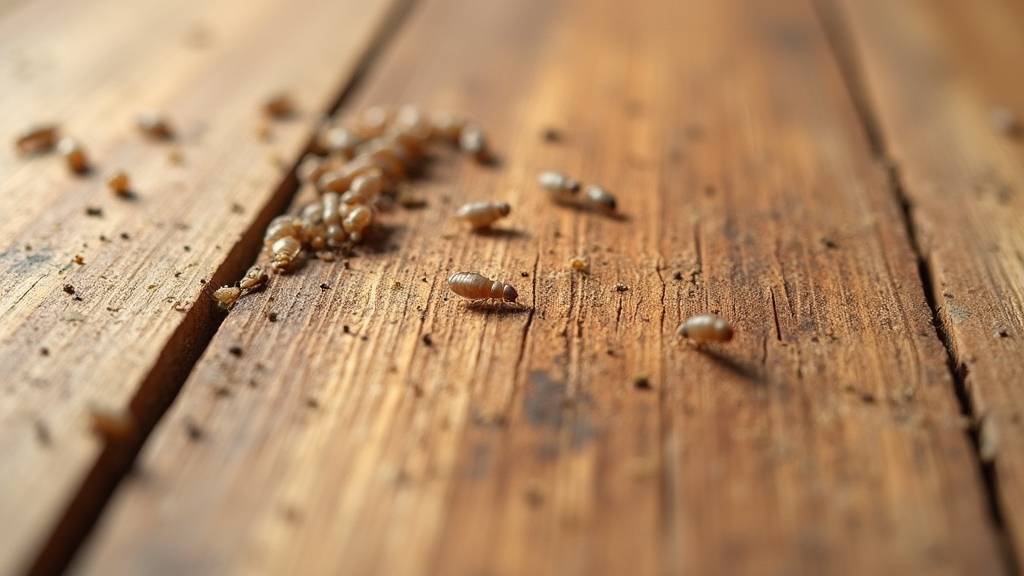
Visible wood damage is a common sign of pest infestations. Termites and other pests eat wood from the inside, weakening it. If you see damage, there may be a serious problem.
Signs include blistering, splintering, or wood that sounds hollow when tapped. Paint may peel if pests have weakened the wood underneath. Door frames, window sills, and beams are key areas to check.
Buyers often look for these warning signs. Early detection can protect property value. Proper assessment and honest disclosure help avoid future disputes. Recognizing structural concerns is essential for sellers and buyers alike.
Mud Tubes Along Foundations
Mud tubes along foundations are a common sign of termite activity. These tubes look like thin tunnels made from soil and are often found on foundation walls. Termites use them to travel safely between the ground and wood. A proper classification of property can help determine if pest damage impacts the home’s value and how it should be addressed in the sale process. If you see these tubes, termites are likely present or have been recently. Paint bubbling near the foundation can also mean termites are tunneling behind walls.
Foundation cracks can give termites easy access to your home. Home buyers watch for these warning signs during inspections. If mud tubes or damage are found, they might lower their offer or walk away. Quick action can protect your home’s value and structure. Being aware of property liens and their impact can also help in addressing underlying issues that might compromise your home’s condition or sale process.
Hollow-Sounding Timber
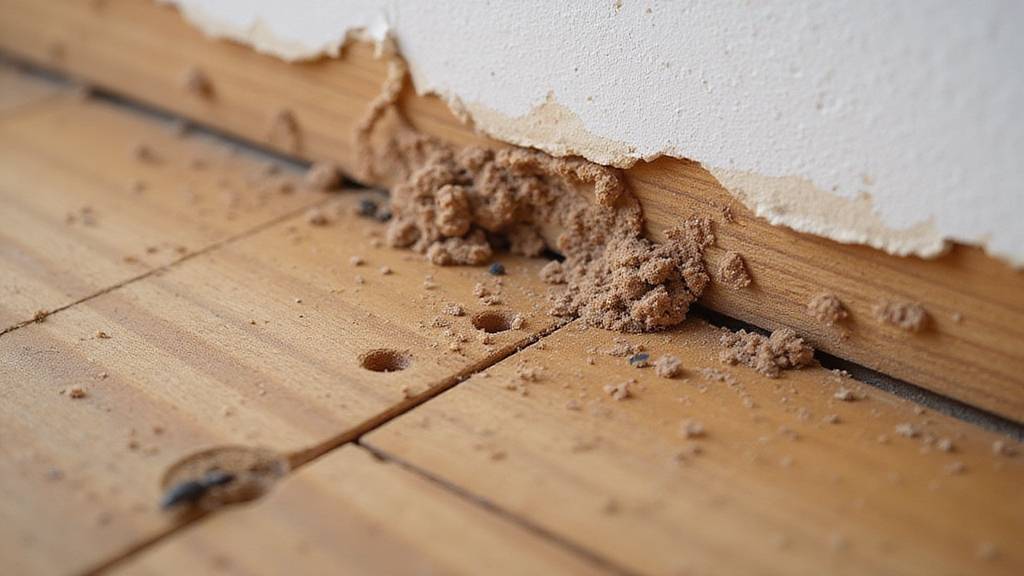
Timber that sounds hollow when tapped may mean termites are present. Termites eat wood from the inside, leaving the surface unchanged. This damage is hard to see without a physical check. A structural weakness caused by internal termite activity can compromise the integrity of the wood, increasing safety risks. Buyers should tap beams and skirting boards to listen for hollow sounds.
If the wood sounds faint or papery, termites may be inside. Irregular wood grain or blistering can also signal trouble. A hidden infestation can remain undetected until it causes significant damage. A musty smell is another common sign of termites. If you notice any of these signs, there could be a hidden colony. Always inspect wood carefully before making a purchase.
Discarded Insect Wings
Discarded insect wings are a sign of termites in the house. These wings are often found near windows, doors, or along baseboards. Their presence means termites may be starting new colonies inside the building.
Understanding local market conditions can help sellers better assess the urgency of addressing pest issues. If you see these wings, it suggests there was a recent swarm. This stage is different from finding pest droppings, which show ongoing activity. The wings show that termites are moving in and settling.
Buyers should know that discarded wings can affect a home’s value and strength. Sellers might remove these wings to hide the problem. A professional inspection checks for these signs to see how serious the infestation is.
Unusual Wall or Ceiling Stains
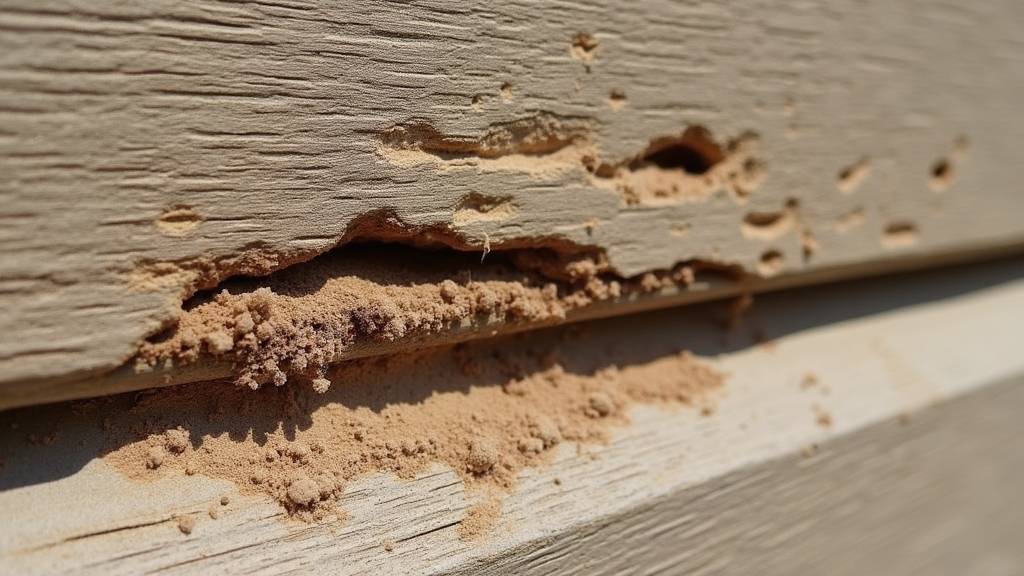
You’ll want to watch for irregular discoloration or dark patches on walls and ceilings, as these patterns often signal pest activity behind surfaces. Such stains frequently indicate moisture accumulation, creating optimal conditions for infestations and structural degradation.
Identifying these anomalies early positions you to address underlying moisture traps and mitigate associated risks efficiently. Additionally, understanding property condition can help buyers assess potential pest-related issues more accurately, especially when combined with knowledge of pest damage signs to evaluate the severity of an infestation.
Discoloration Patterns to Notice
Discoloration on walls or ceilings often signals pest problems. These marks can reveal hidden pests like rodents or insects. Home buyers should always check for these patterns before making decisions.
Yellow or brown streaks along framing may show where pests travel. Spotty, uneven paint patches might mean termites are damaging the walls. Dark smudges or trails near baseboards can point to rodents or insects.
If you notice these patterns, further inspection is needed. Such signs give you early warning of possible infestations. Recognizing them helps you make informed choices about a property.
Moisture Traps and Risks
Unusual stains on walls or ceilings often mean there is trapped moisture. Moisture attracts pests, such as termites and other insects. These stains are usually a sign of water getting in from leaks or condensation.
If you see stains near windows, pipes, or roof edges, there may be a leak. Damp areas provide a perfect place for pests to live and breed. Homeowners should check the source of any unexplained stains right away.
Visible moisture damage can worry buyers because it suggests pest problems and possible damage to the building. If you fix leaks quickly, you can protect your home’s value. Good moisture control is important for a healthy and safe home.
Small Holes in Drywall or Wood
Small holes in drywall or wood often mean there are wood-boring pests. These pests can be termites, carpenter ants, or powderpost beetles. Such holes are not just minor flaws and may show hidden damage inside.
If you see these holes, check for sawdust piles below them. Sawdust, also called frass, is a sign of active pests. Paint bubbling or cracked walls can also mean deeper problems.
You might notice tiny mud tubes on foundation walls. These tubes are a clear sign of subterranean termites. Holes in odd patterns can help identify which pest is present.
If you find these signs, consider a professional inspection. Early action can prevent bigger repairs later. This process involves understanding building code violations and how they impact property value. Properly addressing and disclosing pest damage and related issues can help you make informed decisions about necessary disclosures and repairs.
Sagging Floors or Ceilings
Sagging floors or ceilings often mean there is serious structural damage. Pests like termites weaken support beams by eating the wood. If you see these signs, the home’s structure may no longer be safe. Legal hurdles such as title issues or hidden liens can also complicate repairs and the sale process, making it crucial to address these problems before proceeding. Buyers should check for uneven floors or bowing ceilings during a home visit.
These issues suggest pest damage has gone deep into the structure. If you find sagging, repairs may cost a lot of money. Sagging floors or ceilings can lower the property’s value. Sellers may need to fix these problems before selling. Accurate pricing is essential to attract buyers and account for potential repair costs. If left unchecked, these issues can stop a sale or lower the offer price.
Accumulation of Frass or Sawdust
You’ll spot pest activity by identifying frass piles—fine, pellet-like debris—or sawdust accumulating near wood structures. Unlike household dust, these materials have a distinct texture and location, signaling active infestation. Recognizing these differences enables timely intervention and minimizes structural risk. Being aware of local pest control options can further assist in effective treatment and prevention.
Identifying Frass Piles
Frass piles are small heaps of wood dust left by wood-boring insects. These piles often mean there is active pest damage. If you see frass, there may be hidden problems in the wood.
Frass looks like fine, powdery dust or small pellets near wooden surfaces. You may notice it at the base of walls, joints, or under wooden furniture. The dust does not have the wood’s natural grain.
A faint, musty smell sometimes comes from frass piles. This scent can help you find areas of active infestation. If you notice this smell, check for more signs of pests.
Buyers should take frass piles seriously. These piles often mean there is damage that may need repairs. If you find frass, consider further inspection or professional help.
Sawdust Near Wood
Sawdust near wood can be a warning sign of pests. If you see piles of sawdust, you should check for insect activity. Termites and carpenter ants often make this wood dust as they dig through wood.
The sawdust, called frass, usually gathers under small holes or along seams in the wood. If you notice regular piles, there may be an active infestation. This can harm the strength and safety of the property.
Buyers should look closely at sawdust near walls, beams, or supports. If you find these signs, you may need to plan for repairs. Knowing the cause early can help you avoid unexpected costs and make better decisions.
Differences From Regular Dust
Regular dust is made up of tiny particles from skin, fibers, and dirt. Pest dust, like frass or sawdust, looks and feels different. If you notice unusual dust after cleaning, it may mean pests are present.
Frass has a grainy texture and varies in color. It often looks like small wood shavings or pepper-like pellets. Technical buyers know frass is not as fine as regular dust.
Sawdust from pests collects in piles under damaged wood. Regular dust spreads out evenly in the room. Pest dust may also contain insect body parts or waste.
If you see these differences, you should check for pests. Identifying frass early can help prevent more damage. Always look for signs of pest activity if dust looks unusual.
Unexplained Musty Odors
A persistent musty odor often means there are hidden pests like rodents or insects in the property. This smell can come from mold or mildew growing in damp areas created by pests. If you notice this odor, it may signal a serious problem needing attention. Addressing property defects early can prevent further damage and costly repairs.
Rodents and insects leave behind organic debris, which adds to the musty smell. Termites can create wet spots in wood, helping mold grow. Pests may also make scent trails that other pests follow, making the odor worse.
Unexplained musty odors are a warning sign during property inspections. They can suggest hidden damage and repair costs. If you address these odors quickly, you can protect your property’s value and help buyers feel confident.
Blistered or Peeling Paint
Blistered or peeling paint on walls or ceilings can mean there is a pest problem. If you see these signs, termites or other insects may be damaging the wood. Moisture trapped behind damaged surfaces often causes the paint to bubble or peel.
Buyers notice paint problems because they can point to hidden damage. Blistered paint, fading color, or flaking near baseboards may mean pests are present. If these issues appear, you should check for further damage.
Addressing paint problems early can protect the value of your home. Quick action also helps avoid bigger repair costs later. If you fix these signs soon, future problems become less likely.
Noisy Walls or Clicking Sounds
You’ll often hear unusual clicking noises or subtle movement within your walls when pests are active. Recognizing these distinct sounds, especially during evening or nighttime peak activity, helps you differentiate between structural noises and pest infestations. Accurate identification of auditory indicators is critical for prompt intervention and damage mitigation.
Identifying Unusual Clicking Noises
Unusual clicking noises in walls often mean there are pests. Termites, carpenter ants, or rodents can cause these sounds. Normal house creaks are different from regular or loud tapping noises.
Clicking sounds from pests usually repeat or get louder at night. Termites may make clicks by banging their heads or shaking. These noises are not like electrical sounds, which stay steady as a hum or buzz.
If you hear clicking, notice when and how often it happens. Check if the sound is stronger near wood or baseboards. Look for links with electrical items to rule out electrical problems.
Paying attention to these signs can help you spot pests early. Early detection can prevent bigger problems in your home.
Distinguishing Pest Movement Sounds
After you hear strange clicking sounds, it is important to identify which pest is making them. Each pest creates its own movement and feeding noises. Knowing these sounds helps you find out what type of pest is present.
Termites usually make soft, rhythmic tapping sounds. Carpenter ants often cause rustling or soft crunching noises. Rodents are louder and make scurrying or gnawing sounds.
If you use sound detection tools, you can spot pests more accurately. Regular monitoring can show the level of pest activity. This information will help you choose the right removal method.
| Pest Type | Typical Movement Sound | Detection Reliability |
|---|---|---|
| Termites | Faint tapping or clicking | High |
| Carpenter Ants | Rustling or soft crunch | Moderate |
| Rodents | Scurrying or gnawing | High |
Peak Activity Noise Times
Peak activity noise times are when pests make the most noise. These times are usually at dusk, night, or early morning. Pests are more active when the house is quiet.
Rodents and termites are often heard during these hours. If you listen closely, you might notice sounds from inside walls or ceilings. These noises can help you spot an infestation early.
You may hear soft clicking or tapping from termites if they are present. Rodents may cause scratching or scurrying sounds at night. Sudden bursts of noise in the early morning or evening can also mean pests are active.
Presence of Insect Droppings
Insect droppings, also called frass, are a clear sign of pest activity. These droppings often look like small pellets or fine powder. Finding them means there may be a pest problem in the property. Insect droppings, or frass, are a clear indicator of pest activity and could signal a larger infestation in the property.
You may notice frass near baseboards, windowsills, or behind appliances. These spots are common hiding places for pests like termites or cockroaches. If you see droppings in several areas, there is likely an active infestation.
Frass can damage a property’s structure over time. If buyers find these signs early, they can ask for repairs or pest control. This helps protect their investment before making a purchase.
Damaged or Chewed Wiring
Damaged or chewed wiring is a clear sign of pest problems. Rodents and some insects often chew on electrical wires. If you see this damage, there is a risk of fire and expensive repairs.
Electrical panels, junction boxes, and exposed wires should be checked for gnaw marks. Melted or frayed insulation may expose copper or aluminum wires. If you notice these signs, a professional should inspect the wiring.
Flickering lights or tripped breakers can mean hidden wire damage. Debris or droppings near wires may show active pest routes. If these issues are found, repairs and pest control are needed.
Early detection of wiring damage can prevent serious safety hazards. It also helps you negotiate better terms when buying a property. If you act quickly, you can avoid bigger problems later.
Nests or Pest Remains in Attic or Crawl Spaces
When you inspect attic or crawl spaces, you should identify active pest nests, as these signal ongoing infestations. Watch for concentrated droppings, shredded insulation, and other debris, which indicate areas of frequent pest activity. Don’t overlook insect shells or exoskeletons, as their presence often correlates with established colonies requiring targeted remediation.
Identifying Active Pest Nests
Active pest nests show pests are living in your attic or crawl space. These nests mean there is an ongoing infestation. If you find them, you may face property damage and health risks.
Nests often use fresh shredded insulation, chewed wood, or termite tubes. You might see live pests or recent movement around these areas. Moisture or warmth can also mean the nest is still active.
If you spot these signs, you should act quickly to prevent further damage. Early discovery helps protect your property’s value. Buyers often want homes without active pest problems.
Recognizing Droppings and Debris
Even small amounts of droppings or pest debris in attics or crawl spaces mean pests are present. These signs show a recent or active infestation. If left unchecked, they can harm your home’s structure.
Termite droppings look like tiny, wood-colored pellets. Rodent droppings are darker and shaped like small cylinders. Chewed insulation, nesting bits, or insect parts are other clear warning signs.
Buyers may see these signs as proof of poor maintenance or hidden damage. If you clean up debris quickly, you protect your home’s value. Real estate markets often lower prices for homes with visible pest remains.
Inspecting for Insect Shells
Inspecting for insect shells helps reveal pest problems in a home. Attics and crawl spaces often hide insect shells, nests, or remains. These signs show if there is or was an infestation.
Buyers should look for insect shells, shed wings, and termite patterns on wood. Mud tubes near beams or insulation also signal termite activity. Nests or piles of debris in corners may mean pests are present.
Finding these clues early can help you negotiate repairs. If you spot them, you may need pest control. Early action protects your property’s value.
Conclusion
If buyers know what signs to look for, they can avoid costly surprises from termite or pest damage. Careful inspection of stains, hollow-sounding wood, or mud tubes can save money and stress. If you act quickly, you protect your investment and make better decisions.
If you want to skip the hassle of repairs or inspections, we buy houses for cash in any condition. Sellers can avoid lengthy processes by working with a trusted buyer. Align Real Estate Solutions offers a simple and fast way to sell your home.
If you are ready to move forward, contact us today. We can provide a fair cash offer and expert guidance. Let Align Real Estate Solutions help you sell your house with confidence.
Author
-

Zach Koops is co-founder and Real Estate Success Manager at Align Real Estate Solutions, serving homeowners across Virginia since 2024. With a passion for real estate and a heart for people, Zach has built his career around helping sellers navigate tough situations—foreclosure, inheritance, relocation, repair-overload—with clarity and compassion. He’s known for being straightforward, steady under pressure, and deeply invested in relationships. Outside of work, he spends his time as a husband and father, enjoys the outdoors in Shenandoah Valley, loves singing on stage, and constantly seeks growth through reading and new experiences.

